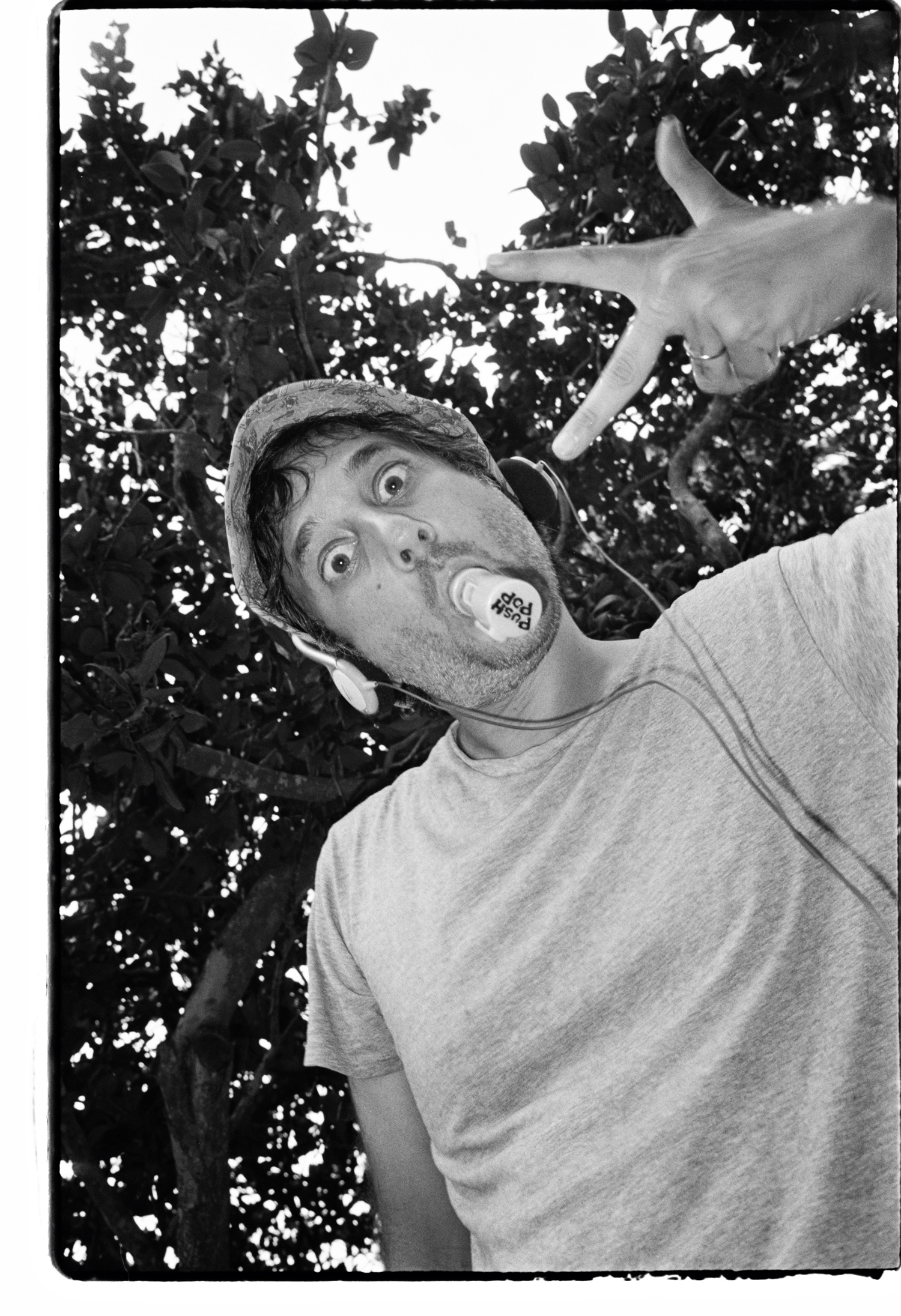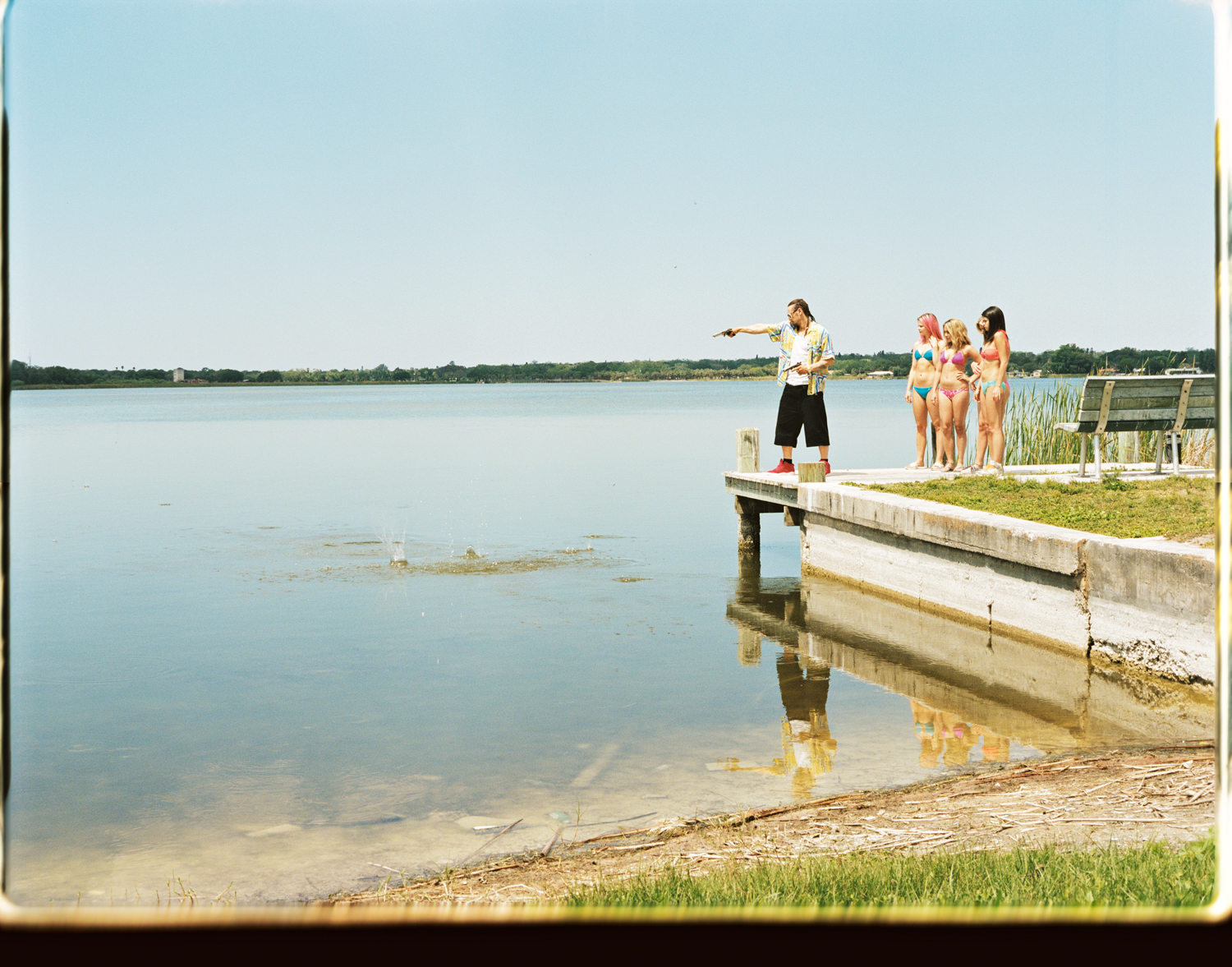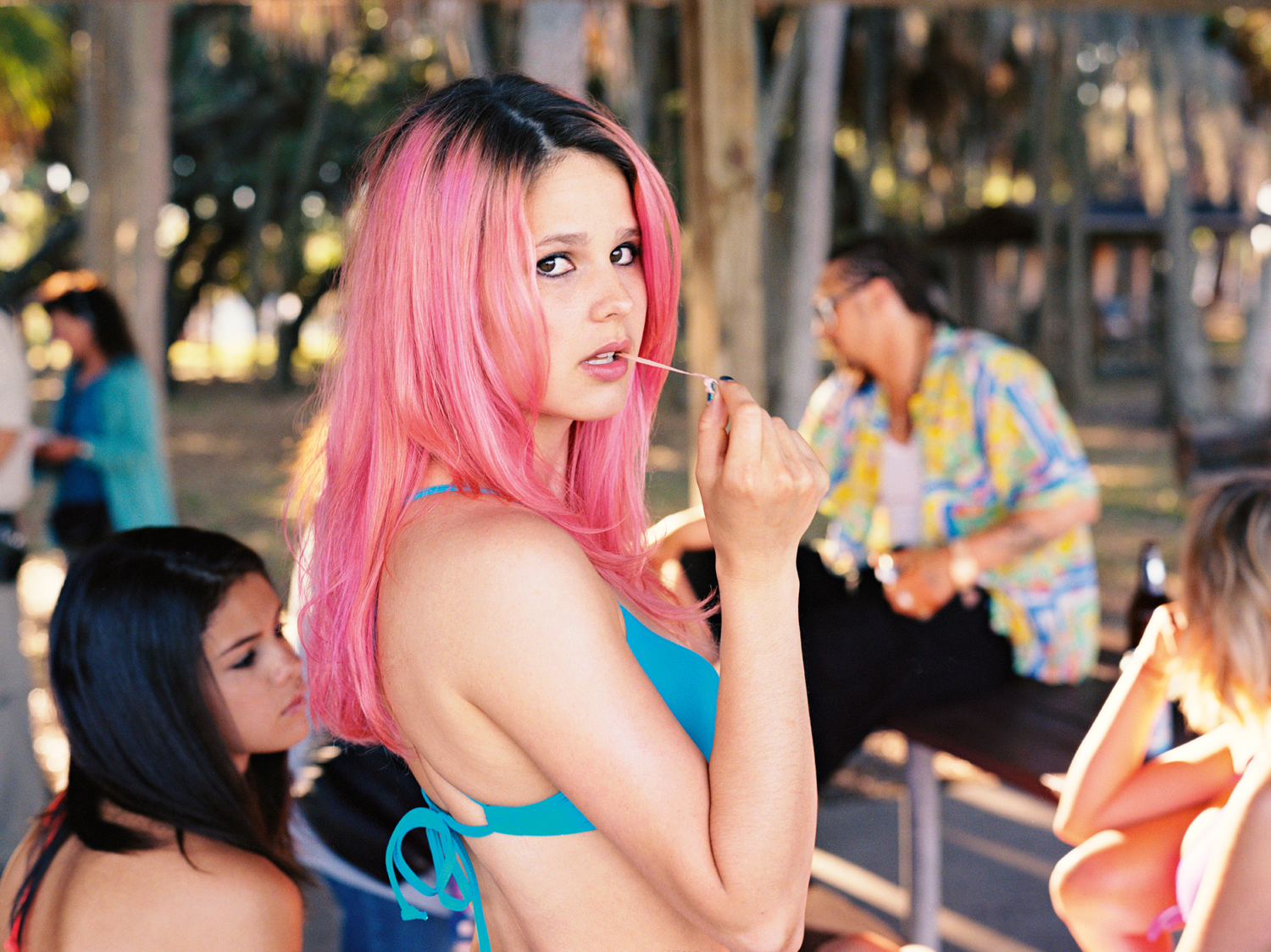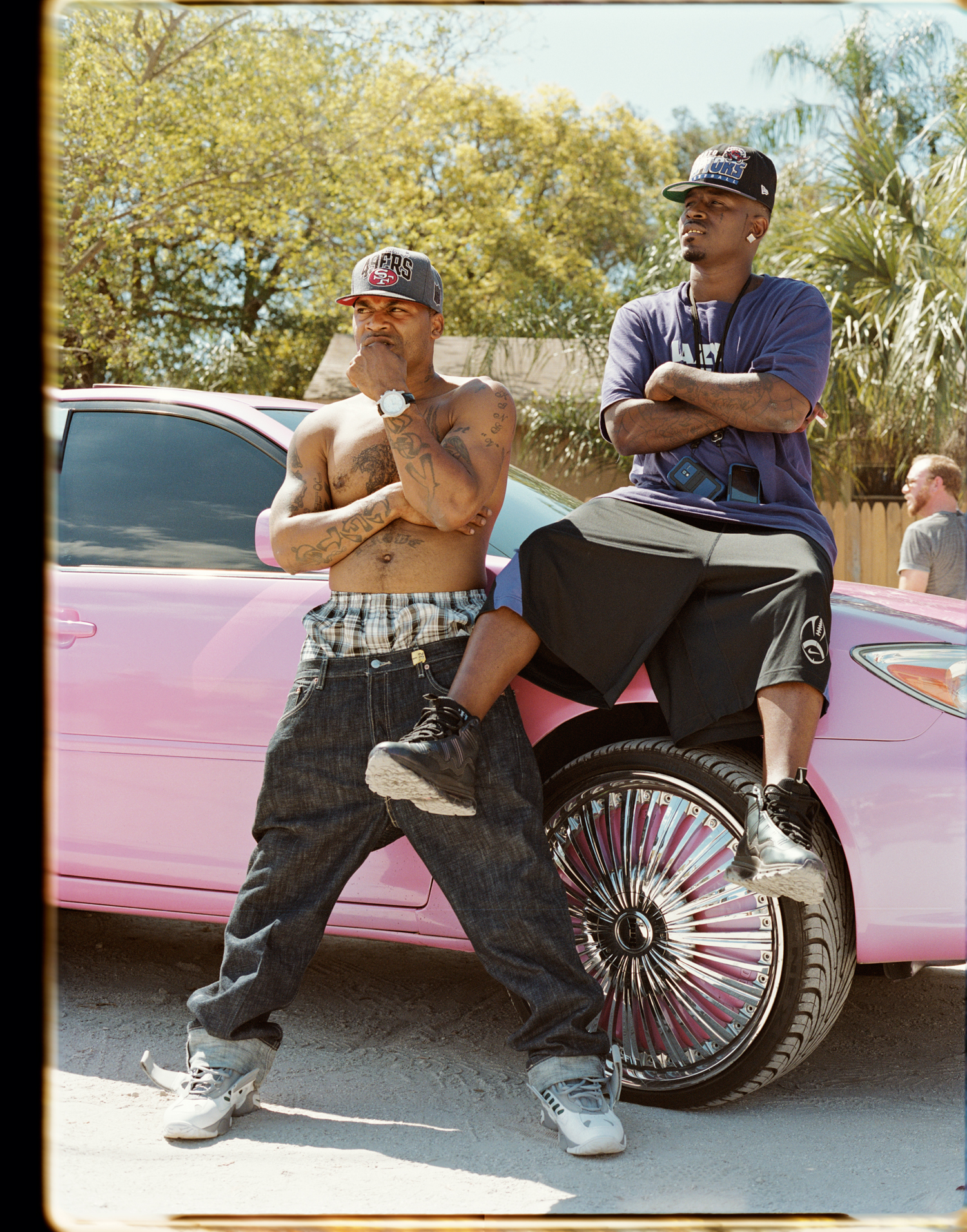Purple Magazine
— S/S 2013 issue 19
Harmony Korine
spring breakers
interview and photography by ANNABEL MEHRAN
It’s been two decades since a 19-year-old Harmony Korine wrote the critically acclaimed screenplay for Larry Clark’s film Kids. Since then, he has written, directed, and produced a wide-ranging body of books, screenplays, and films. For the underground community of artists, his body of work composes a masterpiece. And yet he has never achieved mass-market success — even though, in 2009, Harmony won the Copenhagen International Documentary Film Festival’s prestigious DOX Award for his film Trash Humpers, which he wrote and directed. With his fourth feature film, Spring Breakers, Harmony hasn’t lowered his artistic standards. But with this film, by making what he calls a “pop movie” — and casting Disney favorites and teen stars Selena Gomez, Vanessa Hudgens, and Ashley Benson, along with the prolific James Franco, and shooting them all under the Florida sun — he clearly decided to address a wider audience. We asked Harmony how he came up with this magic cocktail of experimental art and how it might just reach that audience.
ANNABEL MEHRAN — How did you come up with the idea for Spring Breakers.
HARMONY KORINE — Two years ago I was at home alone for Christmas. My wife Rachel and my daughter Lefty were in New Mexico, and I just started playing around with this idea. I had been collecting spring break imagery for a while, like college kids being debauched and messed up — redneck Riviera imagery. I just started thinking about girls in bikinis robbing people.
ANNABEL MEHRAN — With this film, did you consciously try to propose a commentary on youth culture today?
HARMONY KORINE — I never really think about pushing any message. I knew it was going to be current in the way that it looked and would feel, and that the movie would unfold almost like a pop poem or something. But the commentary and all that stuff, for me, it comes after the fact. I feel like the characters are a reflection of something, but I never set out to say anything specific. You want the films to have some type of greater purpose, but I don’t ever start with that. I try to move in the direction of something more inexplicable or more like a physical experience. So I wanted this movie to feel like you were being drilled with images and sounds. It was more of an emotion rather than some type of specific commentary.
ANNABEL MEHRAN — This film is so different from anything you’ve ever done before. Did you want to communicate with a different audience?
HARMONY KORINE — I don’t know. Maybe. It was more like I wanted to see a movie. I wanted to make a movie like this with micro-scenes, you know? A kind of looping trance cinema. The style was something I’d been wanting to try in long form for a while. I’d done it in advertising and in shorter videos, but I wanted to make a film that worked like this kind of frenetic piece of pop poetry, this kind of relentless inundation where images and sounds were kind of just falling from the sky. And I set certain rules when I was writing it: I would never write scenes that were more than one page per scene; or I would try to at least have four or five locations per page per scene. It was a challenge. I wasn’t really referencing cinema as much as I was thinking about other things like art or even YouTube clips.
ANNABEL MEHRAN — The movie is so musical.
HARMONY KORINE — In some ways it was meant to be. In the beginning, I was telling people working on the film that it should be more like a violent pop song. It should be very quick. It should hit you very hard and it should leave.
ANNABEL MEHRAN — Were you worried at all about being able to make something that’s usually four minutes long into something that’s 90 minutes long?
HARMONY KORINE — Yeah. I was because, at the same time, I didn’t want it to be like a music video, where there is the risk that you can destroy the image for the sake of being fast. For the first two weeks before I had really seen scenes cut together, when we were shooting, I was like in hell because I was so nervous as to whether it was actually going to work.
ANNABEL MEHRAN — How did you make those slow-motion watercolors?
HARMONY KORINE — I think there were five or six little cameras rolling simultaneously. They were all placed on different settings: black and white, etc. The movie was shot with seven different cameras simultaneously. There’s maybe 400 hours worth of film. I didn’t end up using a lot of it. I wasn’t even sure when we were making it how I was going to incorporate it because it’s such a stylistic jump.
ANNABEL MEHRAN — It’s really trippy and feels like you’re partying.
HARMONY KORINE — Yeah, so I used it more sparingly. I tried just using it because it looked cool in certain sequences, just for the sake of it, but it kind of took me out of the movie. And I didn’t want to do anything too literal like it was cell-phone footage or something. It was more like a physical reaction to what you’re seeing onscreen.
ANNABEL MEHRAN — As a sober person, when you’re doing a movie about people getting wasted, are you getting a contact high off that?
HARMONY KORINE — No, when I’m making a movie, I don’t ever really get lost in it like that. I always think about it like, it’s always so hard making a film, I’m always hyper-conscious of what I want to do and making sure that things are right. I don’t ever get lost in the subject matter. Watching people fuck on screen or get high or kill people, it’s nothing to me past what it’s going to be in the film
ANNABEL MEHRAN — When I was on the set, it felt like there was this wildness to everything. It was so free, like a party in a beautiful but very safe environment. Did you leave a lot of space for improvisation?
HARMONY KORINE — Well, I had the script and I knew the story. But I was thinking about the characters more than anything. I never think about messages in that way.
ANNABEL MEHRAN — How did you gather inspiration for the characters?
HARMONY KORINE — From different Web sites — party sites, amateur porn sites, college co-ed frat sites, things like that. Also, I had some friends in this art collective, the Cum Brothers — they changed their name to Leo Gabin — and they had collected a lot of this imagery. We were trading things back and forth for a while. I had files of it. A lot of scenes were based on specific images as well as memories from my childhood. Growing up in Nashville, everyone would go to Daytona Beach for spring break. In high school there were so many stories of things that would happen there. I’ve always thought it was a uniquely American phenomenon. It has all these qualities that are exciting: violence, sex, debauchery. And I love the idea that when kids go back to school, they just return to their normal life. At the same time, in the movie the actual spring break is really only 10 minutes of the film. So the idea is more metaphorical, and it quickly becomes something else.
ANNABEL MEHRAN — How long did it take you to come up with the idea for James Franco’s character, Alien?
HARMONY KORINE — Not long. I started thinking about these girls and why they would start robbing places. Why would they turn to violence? I thought it would have to be that they’d met a guy. I started imagining what type of guy it was, just like a white gangster rapper. I just made the whole thing up.
ANNABEL MEHRAN — Did the idea to get Disney girls in the movie come right away, too?
HARMONY KORINE — Yes. My very first question was, “If you could cast anyone, who would it be?” I just wanted Disney girls. That was the dream. But at the same time, I wanted to make sure that they could do what I needed them to do.
ANNABEL MEHRAN — Did you have any fear in the beginning that Selena Gomez wasn’t going to be able to go for it?
HARMONY KORINE — No. I just make it happen. It’s strange, but I don’t have fear in people’s ability. You just set it up in a certain way that allows them to be free enough to perform. The idea is to create an environment where there are no mistakes, where everything’s perfect. Where everything is beautiful and where the acting, the locations and the camera work is always perfect. Or maybe it’s the mistakes or the awkwardness of the situation that creates the beauty and the interest — the drama. A lot of it is chemical. I used to call it a mistake-ist art form, meaning that you were putting these chemicals in a jar and shaking it up and documenting the explosion. You light it the way you want it to be lit.
ANNABEL MEHRAN — It seemed like there were no mistakes. Everywhere we walked ended up looking perfect.
HARMONY KORINE — Most of the work is picking locations. It just comes from spending a lot of time in cars, driving around and getting lost, and then finding places that visually match your dreams.
ANNABEL MEHRAN — Where did you write the script?
HARMONY KORINE — Originally, I had thought I would work on it in Daytona Beach, but when I flew down there it was just fat bikers and lesbians. There weren’t any spring breakers at all. A lady explained to me that they ran them off like 10 or 15 years earlier. So then I jumped on a plane and went to Panama City, Florida, which was where it all was.
ANNABEL MEHRAN — That’s where MTV does it.
HARMONY KORINE — I had to write it in three or four hotels because it was so disgusting. People were just vomiting on your fucking doorstep all the time, blasting Taylor Swift, fucking sand everywhere, everyone pissing everywhere. It was like a bunch of animals. It’s amazing, actually. It’s incredible: people were just tearing shit down. People were just setting things on fire and fucking and, like, killing each other. It was great.
ANNABEL MEHRAN — Did you ever have those kinds of experiences when you were that age?
HARMONY KORINE — Oh, no. I never did go. In the late-’80s, early-’90s, when I was that age, I was more into skateboarding and stuff like that. But I would’ve loved to go to, like, Freaknik, the black version. That’s even more interesting to me. That seems even way better.
ANNABEL MEHRAN — Were you aiming for a larger audience with Spring Breakers?
HARMONY KORINE — It didn’t start out like that, but then I started thinking, “Well, it’s a pop movie in a lot of ways, and I love the idea of working with these girls in this world…” Some of the other films I’d done were much more out-there and limited in their appeal. With this one, I felt from the beginning that I wanted as many people to see the movie as possible.
ANNABEL MEHRAN — Did you ever worry that having people like Selena Gomez, who are attached to huge companies like Disney, or even with James Franco, that they were going to somehow take control of your project?
HARMONY KORINE — Oh no, no. No.
ANNABEL MEHRAN — That doesn’t happen?
HARMONY KORINE — Nah. No one fucks with me.
ANNABEL MEHRAN — Let’s talk about the ATL twins.
HARMONY KORINE — By now everyone knows them, so I feel weird even explaining who they are.
ANNABEL MEHRAN — Why did you want to bring them into the movie? Because I feel like they really changed the set.
HARMONY KORINE — In what way?
ANNABEL MEHRAN — Even just to see Selena Gomez in between these two crazy pervs — and loving it, because they’re so sweet — and they’re talking about disgusting shit, doing disgusting shit all the time, all out in the open.
HARMONY KORINE — That’s why I think the ATL Twins are amazing. There’s no filter and there’s no shame. It’s amazing because, really — philosophically — everything with them boils down to the quest for the double penetration. Do you know what I mean? That’s at the core of who they are — all they want to do is double-penetrate the same bitch. Like, that’s it. What can you say to that? It’s like they’re characters. And like you said, there’s a sweetness that they have, too. So, yeah, it’s fun for me to put them in. They embody a lot of the mood and psychology of the movie, even though they don’t say a word in the film.
ANNABEL MEHRAN — They don’t have any lines?
HARMONY KORINE — No, they’re just Alien’s henchmen. But, that’s what I meant before: you take different pieces and you put them together and you document the explosion.
ANNABEL MEHRAN — How long did you shoot?
HARMONY KORINE — Just one month. The idea was to turn the lack of time into an asset. You just make the camera fly the whole time. You just drop it from ceilings and it goes through potholes and into the sky. And it’s just like god.
ANNABEL MEHRAN — You shoot in some dangerous places. For instance, that pool hall in the ghetto. Do you ever worry that something might really go wrong?
HARMONY KORINE — I don’t think in terms of fear. All I care about is making great work, great movies. Obviously, I don’t want anyone to get killed, or anything horrible to happen, but you just do what you have to do. And at the same time it’s exciting because things can go bad. But even if they do, maybe it will be amazing. In some ways, shooting in those pool halls and those dangerous areas is, like, my favorite thing. If I could just do that all the time, I’d be happy. In general, I don’t like going to places where I know people have filmed before. I especially don’t like going to places where too many white people have filmed. ‘Cause it’s true: white people ruin everything. They destroy it all.
ANNABEL MEHRAN — Well … you’re white.
HARMONY KORINE — Yeah but I don’t really count, I’m extraordinary.
ANNABEL MEHRAN — It’s true! I’m not going to argue with you. And what about putting your wife, Rachel, in the movie? Did you always know she was going to be one of the girls?
HARMONY KORINE — Yeah, from the very beginning. I knew she would be fearless in the film and she would get the other girls going.
ANNABEL MEHRAN — She really does, too. When we were shooting at that pool hall, the girls were so scared in the van, but she ran out. Do you remember? She was dancing in her bikini?
HARMONY KORINE — Yeah, she’s like me in the way she just sees the good in things and doesn’t feel fear. She’s bold. That’s cool.
ANNABEL MEHRAN — Was it crazy to have her doing the sex scene?
HARMONY KORINE — No, not at all. That’s what I mean: I don’t have any hang-ups with that shit. Watching my wife having sex with someone else on screen just seems completely natural to me because it’s a movie. When someone’s getting killed on film, they’re not really dying. But usually the more other people that are freaked out around me, the better it is for me.
ANNABEL MEHRAN — This is the first movie you’ve made since you had your daughter Lefty. Has having her influenced your work process in any way?
HARMONY KORINE — No, probably not.
ANNABEL MEHRAN — You don’t think about making something that she can see?
HARMONY KORINE — I think she should see this!
ANNABEL MEHRAN — A lot of people who will want to watch this are young Selena fans.
HARMONY KORINE — But they should! I think it should be mandatory viewing.
ANNABEL MEHRAN — Did you have to really prep the girls for their parts?
HARMONY KORINE — Oh yeah, I worked with the girls for a couple of weeks before they came to Florida.
ANNABEL MEHRAN — What were you doing?
HARMONY KORINE — We just talked about things, went over their scenes, the characters, the ideas, the locations. They were actually pretty much a dream. They were just about the easiest actors I’ve ever worked with. For whatever it’s worth, the thing about kids who’ve been through the Disney system is they have a really good work ethic on top of everything else. They have a discipline that is surprising. The Disney kids are hardcore.
ANNABEL MEHRAN — Did you have Skrillex in mind for the score from the beginning?
HARMONY KORINE — Yeah, I wanted Skrillex and Cliff Martinez together. I was already a fan of both. I wanted Skrillex for sure because the music is so physical. It’s experiential; it’s like video game symphonies, pure energy. I wanted the film to work in a very similar way. And I also thought his music is what they’d be listening to. His music has this poppiness to it, and then this harder, abrasive and violent quality that he was mashing up. It seemed like he was of the movie, of the world. And then Cliff Martinez for similar reasons. He has this kind of driving, frenetic sound. His music propels the scenes. Together they were amazing.
ANNABEL MEHRAN — Did they work together on it?
HARMONY KORINE — Yeah, on some stuff. But Skrillex was touring and Cliff makes music in his living room. They would send stuff to each other, but then they did pieces separately, too. We talked about moods and tried different stuff. The movie has almost 80 minutes of music in it. It is like a piece of music. The film itself works like music. You just go for it. Get good people.
ANNABEL MEHRAN — Are you already thinking about the next project?
HARMONY KORINE — I have a couple of ideas. I know I want it to be more violent. But beautiful. Violence can mean so many things: you can have body counts or it can just be a thought.
ANNABEL MEHRAN — Are there specific movies you draw on for inspiration?
HARMONY KORINE — I like Michael Mann’s movies a lot. They’re almost better without the sound and dialogue. There’s a graininess and a kind of analog quality to his films, all these tweaked sunsets and impressionistic colors that are tonally psychedelic and rich. You feel like you’ve lived in those places and you’ve met those people. You’ve smelled the smells; you’ve been with those women. But I don’t really reference movies anymore. I’m not a cinephile anymore. I don’t even watch many movies anymore. I did that when I was younger. The great movies, the great works, they live inside you. They live with you. So I’ve never been one of those directors consciously referencing other work. I’m chasing my own dreams, my own ideas — I don’t really waste time with other people’s. I’m not trying to reinvent old movies. I don’t care about that. I want to make something new. I want to invent that shit.
END







































































































































































